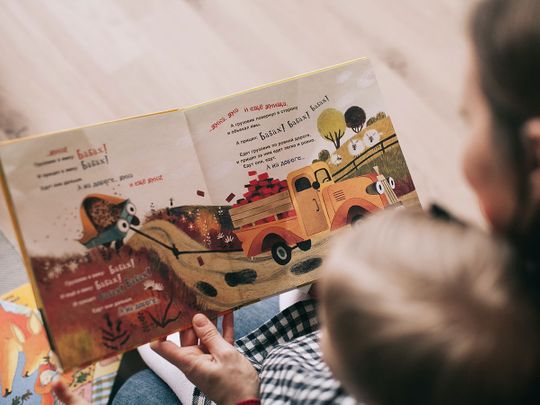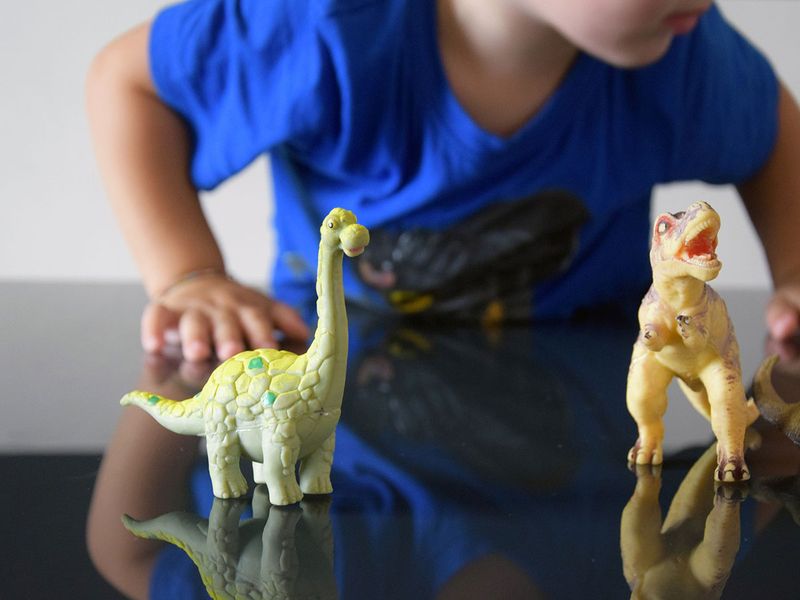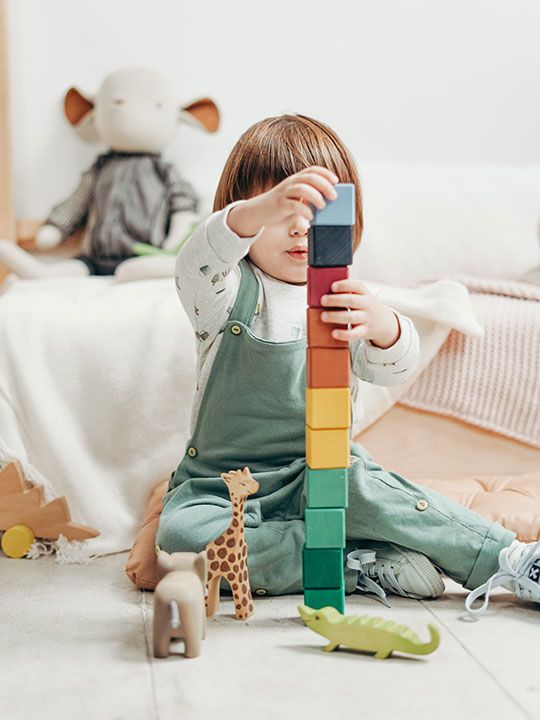
For your child, it is a whole new universe – an ever-changing range of lessons, from arts, languages, science to sports in classrooms with scores of other students, learning to face exciting challenges away from home. In the UAE, this is the age of school entry, beginning a journey of 14 years that will instil a love for lifelong learning and teach your child about friendship, independence and so much more.
Your child can seem like a little adult at this age – solemnly (or dreamily) setting out at dawn for a long day of study and fun. Their vocabulary will have expanded to over a 1,000 words, and they will hold lively conversations about their day, the latest stories they’ve read and their own interests, with their writing, drawing and counting skills developing rapidly as well.
ALSO READ
- All the milestones your baby should be reaching up to six months old
- Developmental milestones for an 18-month-old baby
- All the developmental milestones your two-year-old should be reaching
- Mum to a one-year-old? This is what your baby should be doing at this age
- Parent to a three-year-old? Here’s the developmental milestones they should be reaching
Gulf News spoke to Dr Afra Jamal Ahli, Specialist in Family Medicine and Fellow in Maternal and Child Health at Dubai Health Authority, with the United States Centers for Disease Control and Prevention as an additional source, to find out more about developmental milestones for your four-year-old that you should keep track of.
Social and emotional development milestones for a four-year-old
1. Enjoying new things
With a dynamic kindergarten environment offering novel experiences on a daily basis, your four-year old is expected to be interested in trying these new games and activities, as well as going to new places.
2. More creative pretend play
Pretending that they are a mother or father themselves, imitating their parents, is a specific example of pretend play to look for. They can construct other complex make-believe worlds as well, for example, playing at being a firefighter or a doctor with friends and family members is important for development.
A 2012 study by US-based researcher Michele Root-Bernstein, published in the 'Oxford Handbook of the Development of Imagination', indicated that for the studied creative individuals such as MacArthur Foundation “genius” grant awardees and Nobel Prize winners, playing make-believe worlds or ‘world-play’ during early childhood years were more frequent than other control participants in their fields.
A famously interesting example of such imaginative play is the literary Bronte siblings’ construction of a fantasy worlds called the Glass Town and Angria around their new toy soldiers, writing dozens of books of prose and poetry together. The four siblings were aged between six and ten when they started, with Charlotte being the eldest, and wrote these for many years following, going on to become famed writers.
3. Preferring interactive play
They will prefer playing with friends and family rather than by themselves at this age. Your child will also be more cooperative, and encouraging a range of group activities such as tending to shared houseplants, building Lego towers and cities, or solving puzzles together are beneficial.
However, Dr Afra says, “If they don’t respond to people outside the family, for example, with a teacher, that is a concern to bring up with your paediatrician.”

4. Being vocal about likes and interests
“What is your favourite dinosaur?” As I reply that my favourite one was the brachiosaurus, my little nephew says that his is the tyrannosaurus rex, proceeding to then give an awe-inspiring demonstration of the extinct animal itself, complete with growls and agile scampering. The conversation quickly progressed to favourite pokemons, and Paw Patrol, the popular animated show.
At four years old, your child is expected to vocally express their likes and interests, and this can make for similarly delightful conversation.
5. Often not distinguishing between fiction and reality
Whether your little girl might want to visit Princess Tiana’s restaurant, from The Frog Prince or fly on a magic carpet with Princess Jasmine from Aladdin, a characteristic of this age is finding it hard to distinguish between make-believe they might learn from movies or books and reality.
Language and communication milestones for a four-year-old
1. Knowing some basic grammar
Dr Afra says, “They will try to use grammar correctly by this age.” This includes correct usage of ‘he’ and ‘she’ and some basic sentence structures.
2. Singing a song or poem from memory
“Do you want to build a snowman? / Come on let’s go and play….”
With the animated movie ‘Frozen’ being a universal favourite for children worldwide, this is one of the songs or poems that your child might enjoy singing.
3. Storytelling
After at least a year of preschool and kindergarten, your child will be used to telling you about their day. However, encourage them further to build fictional stories by giving various prompts, for example, “Once upon a time….”
You can take turns with your child to tell the story and at this age, they are expected to actively participate.
4. Saying first and last name, identify family and friends
Your child is expected to begin to knowing last names of people as well, and easily identify familiar people.
Cognitive milestones for a four year old
1. Knowing some colours and some numbers
Babies can start to understand the concept of colour from around 18 months and by now your child should be able to name a few primary colours and also know the names of some numbers.
2. Understanding counting
They are also expected to have started counting, matching numbers to their quantities on cards with repeated colourful objects, for example.
3. Remembering parts of a story
Dr Afra says, “If you tell them a story today, after 2 to 3 days, they remember it and try to tell it by themselves.”
She adds that if they can’t retell a favourite story, parents should be concerned and discuss this with their paediatrician.
You can also ask your child to recall parts after you tell them their bedtime stories.
4. Beginning to understand time
Concepts like morning, evening and night become clear to your child, especially as bedtime and school routines are established. Asking your child about their morning and evening activities separately can support their development in this area.
5. Understanding the idea of ‘same’ and ‘different’
If you show your child various patterns and ask them whether a couple of chosen ones are same or different, at four years old, your child will be able to answer. If not, visit your paediatrician to discuss any concerns.
6. Playing card or board games
There is a huge and colourful range of board and card games for four year olds to choose from, from story cards that let your little one create a small fable of their own to even Uno that focuses at connecting colours and numbers quickly.

Numerical board games can be particularly helpful. A 2011 study by US-based researchers Geetha Ramani and Robert Siegler published in the Journal of Applied Psychology, by American Psychological Association, found that engaging in informal numerical activities like board games can be critical in a child’s early numerical development and can have long-term benefits in the area.
7. Starting to copy some capital letters
At this age, they should be able to start their alphabetical journey by copying capital letters.
8. What happens next in a story
“And so it was almost midnight, and Cinderella had to run away from the ball before her dress and riches disappeared. In the hurry, she left her glass slipper behind and the prince found it. What do you think happened then?”
Your child will be able to offer some ideas for how the story could pan out.
9. Using scissors
Whether during lessons of basic origami or simple tasks like cutting off tags, your child is expected to be using scissors at this age.
10. Drawing basic human figures
According to Ireland’s National Childcare Directory, at four years old, they begin the representational stage of scribbling that progresses into drawing. The era of stick figure drawing is expected to begin and your child should be able to draw a person with two to four body parts.
Dr Afra says, “If your child is having trouble with scribbling, that is a concern.”
Physical development milestones for a four year old
1. Hopping and standing on one foot for up to 2 seconds
Dr Afra emphasises, “This is very important.” It can be for a classic game of outdoor hopscotch, for example.
2. Catching a bounced ball
They should be able to catch a bouncing ball most of the time.
3. Pouring, cutting and mashing own food
Dr Afra says, “For example, - pouring juice, milk or water in a cup, trying to use a knife to cut with supervision and mashing their own food during meals, should be possible.”
Signs of autism to watch out for
An estimated 1 in 160 children worldwide has an autism spectrum disorder, according to the World Health Organization.
According to Dr Afra, although autism is usually detected at 18 months but sometimes it may be hard to notice, especially for first-time parents. By two years, it should be a bit more obvious.
1 in 160
children worldwide has an autism disorder.
Some of the signs, she says, are if the child is not able to make direct eye contact with the parents and if they are not able to say “mama or baba”.
“If the child gets annoyed with listening – if there is a noise in a place and a child cannot bear it, they will close their ears and they will try to shout. If they have a speech delay as well, these are the main signs that identify autism in the MCHAT (The M-CHAT or Modified Checklist for Autism in Toddlers),” says Dr Afra.
She adds that if they are not able to play “pretend”, like holding a phone and trying to speak with it or talking to a doll, those could also be alarming signs for autism.
Signs that can mean your child has ADHD
According to Dr Afra, ADHD (Attention Deficit Hyperactivity Disorder) is usually diagnosed after 5 years and the symptoms include less sleeping hours, eating less and when the child is hyperactive in more than one place – with the parent at home and the teacher at school.
She says, “With ADHD, the child cannot stay still in one place - they will tend to jump from one place to another.”
How can a parent support baby development to ensure these milestones are reached?
Dr Afra says, ”To develop their personality, I suggest your child to pretend play, do playdates with others especially with friends and we can also give them various toys such as kitchen sets and dress-up clothes to build up their imagination.”
She also says that explaining some of your daily actions step-by-step, so that they begin to understand the sequence of events, is also very beneficial.
She adds, “It’ll be good if the parent takes that opportunity to read with them, and after reading, you can ask them to tell you about what they understood from that story.”
- The writer is an intern with Gulf News








